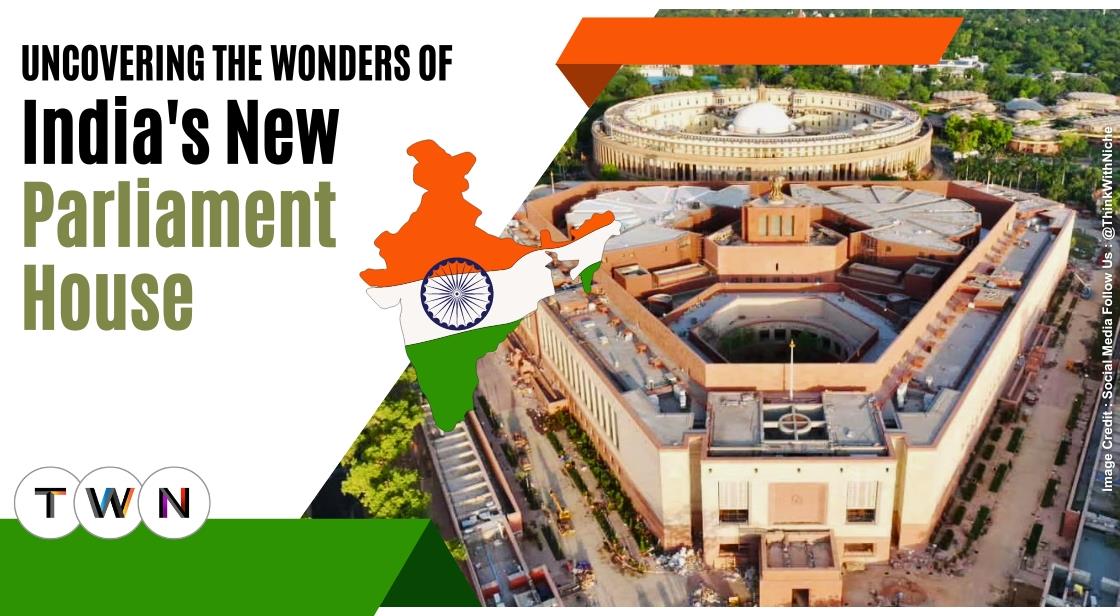Discovering India's New Parliament House: Notable Facts and Impressive Features

Blog Post
India's new parliament building was inaugurated on May 28, 2023, by Prime Minister Narendra Modi. The new building is located in the heart of New Delhi, and it is three times larger than the old parliament building.
India's new parliament building is a symbol of the country's progress and ambition. India's New Parliament House stands as a remarkable testament to the country's progress and commitment to efficient governance.
From the impressive two and a half year construction timeline to the exquisite interior decor, this architectural marvel showcases
The new building has a number of features that make it more efficient and sustainable, including a triangular shape that maximizes space, a green roof that helps to reduce energy costs, and a rainwater harvesting system.
India's rich heritage and forward-thinking vision. With chambers accommodating hundreds of members, exhibition galleries showcasing diverse art forms, and a message of progress from Prime Minister Narendra Modi, the new Parliament House represents the nation's determination to build a prosperous and inclusive India.
Join us on a journey to explore the notable facts and impressive features of this iconic structure.
India's new Parliament House stands as a testament to the country's democratic principles and governance. With its striking architecture and state-of-the-art facilities, the building is a symbol of India's commitment to transparency, inclusivity, and progress.
In this article, we will delve into the important details and fascinating facts about India's new Parliament House, showcasing its significance and highlighting key features that make it an architectural marvel.
Discovering India's New Parliament House: Notable Facts and Impressive Features
-
Inauguration and Notable Attendees:
The new Parliament House was inaugurated with great pomp and ceremony, graced by Prime Minister Narendra Modi and various dignitaries. The event witnessed the presence of Chief Ministers, ambassadors of foreign countries, and other prominent personalities, signifying the significance of this momentous occasion.
-
Location:
The new parliament building is located at 118, Sansad Marg, New Delhi. Sansad Marg is a road in the heart of New Delhi that is home to a number of government buildings, including the old parliament building. The new parliament building is located just north of the old parliament building.
-
Design:
The new parliament building was designed by Bimal Patel, an Indian architect. Patel is a well-known architect who has designed a number of notable buildings in India, including the Akshardham Temple in Gandhinagar and the Sabarmati Ashram in Ahmedabad.
The new parliament building is a triangular-shaped building that is made of white marble. The building has a total built-up area of 64,500 square meters.
-
Construction:
The construction of the new parliament building began in 2019, and it was completed in 2023. The construction of the new parliament building was a major undertaking, and it required the relocation of a number of government offices and the demolition of a number of buildings.
The construction of the new parliament building was also controversial, with some people criticizing the cost of the project and the environmental impact of the construction.
-
Features:
The new parliament building has a number of features that make it more efficient and sustainable than the old parliament building. These features include:
-
A triangular shape that maximizes space
-
A green roof that helps to reduce energy costs
-
A rainwater harvesting system
-
A smart building system that controls the lighting, ventilation, and security systems
-
Accommodation:
The new parliament building can accommodate up to 1,272 members of parliament. The building has two chambers: the Lok Sabha and the Rajya Sabha. The Lok Sabha is the lower house of parliament, and it has a capacity of 888 seats.
The Rajya Sabha is the upper house of parliament, and it has a capacity of 384 seats. The new parliament building also has a number of other facilities, including:
-
Offices for members of parliament
-
Committee rooms
-
A library
-
A cafeteria
-
A medical center
-
Green building:
The new parliament building is a green building, and it has been certified as a Platinum-rated LEED building. LEED is a green building certification program that is administered by the U.S. Green Building Council. The new parliament building meets the highest standards for environmental performance, and it is designed to reduce energy consumption, water consumption, and waste production.
The new parliament building is a symbol of India's progress and ambition. The building is a state-of-the-art facility that is designed to meet the needs of the 21st century parliament. The new parliament building is also a green building, and it is a symbol of India's commitment to environmental sustainability.
-
Architectural Marvel:
The new Parliament House of India boasts a magnificent architectural design that combines modern aesthetics with elements inspired by India's rich heritage. With its imposing structure and meticulous attention to detail, the building stands as a proud representation of the nation's unity and strength.
-
Modern Infrastructure:
Equipped with cutting-edge infrastructure, the new Parliament House incorporates advanced technology and sustainable features. It provides state-of-the-art facilities to support efficient legislative proceedings, ensuring a conducive environment for decision-making and governance.
-
Expanded Seating Capacity:
Unlike its predecessor, the new Parliament House offers an expanded seating capacity to accommodate the evolving needs of India's democratic system. The Lok Sabha Chamber can now accommodate 888 seats, allowing for joint sittings of both Lok Sabha and Rajya Sabha members, while the Upper House chamber provides 384 seats for Rajya Sabha members.
-
Unique Galleries:
Within the new Parliament House, visitors can explore three distinctive galleries that showcase India's cultural heritage. The Sangeet Gallery presents the rich traditions of dance, song, and music, while the Sthapthya Gallery highlights the country's architectural legacy. The Shilp Gallery exhibits the diverse handicraft traditions from different states, showcasing India's artistic prowess.
-
Symbolic Artwork and Decor:
The new Parliament House is adorned with nearly 5,000 pieces of artwork, including paintings, wall panels, stone sculptures, and metal murals. The interior decoration of the Lok Sabha Chamber features a captivating peacock motif on carpets, ceilings, and lattice work, while the Rajya Sabha chamber is adorned with the elegant lotus motif, representing purity and spiritual enlightenment.
-
Vision for a Developed India:
During the inauguration, Prime Minister Narendra Modi emphasized the vision of a developed India as the nation approaches its 100th year of Independence. He called upon every citizen to contribute towards the progress and prosperity of the country during this transformative phase of "Azadi ka Amrit Kaal."
Use of latest technologies in new parliament building:
-
Audio-visual systems:
The new parliament building has state-of-the-art audio-visual systems that allow for clear and concise communication between members of parliament and the public. The systems include high-definition cameras, microphones, and speakers.
Also Read: Explore The Rich History Of The Old Indian Parliament: Spirit Of Indian Democracy
-
Digital language interpretation:
The new parliament building has a digital language interpretation system that allows for real-time translation of speeches into multiple languages. This system is designed to make it easier for members of parliament and the public to understand the proceedings of the parliament.
-
Recording infrastructure:
The new parliament building has a recording infrastructure that allows for the live streaming of the proceedings of the parliament. This infrastructure is designed to make it easier for members of the public to follow the work of the parliament.
-
Smart building system:
The new parliament building has a smart building system that controls the lighting, ventilation, and security systems. The system is designed to reduce energy consumption and improve the comfort and safety of the building.
-
Green building technologies:
The new parliament building is a green building, and it uses a number of technologies to reduce its environmental impact. These technologies include solar panels, rainwater harvesting systems, and energy-efficient lighting.
The new parliament building is a state-of-the-art facility that is designed to meet the needs of the 21st century parliament. The building is equipped with the latest technologies and facilities, and it is a symbol of India's commitment to environmental sustainability.
Obeetee Carpets: Weaving Elegance for India's New Parliament House
When Prime Minister Narendra Modi unveiled the montage of the new Parliament building, attention was drawn to the vibrant and captivating carpets adorning the houses. These stunning carpets added a touch of elegance and color to the otherwise solemn amphitheatres, perfectly complementing the highlighted walls.
From British Entrepreneurs to Indian Artisans: Obeetee's Remarkable Journey
Obeetee Carpets, the creators of these exquisite carpets, boasts a remarkable history of 103 years, tracing back to its founding by three British entrepreneurs immediately after World War I. The company derived its name from the initials of these visionary individuals.
Today, Obeetee collaborates with over 20,000 skilled artisans, showcasing their craftsmanship ranging from 15 knots to 300 knots per square inch.
With its vast experience and rich heritage, Obeetee utilized only the finest quality, 100% pure New Zealand wool for the Central Vista project, a monumental undertaking that spanned nearly two years.
The process of crafting these exceptional carpets began in 2020, amidst the challenges of the global pandemic. The weaving process commenced in September 2021 and reached completion by May 2022, followed by the installation phase in November 2022.
Over 900 dedicated weavers, hailing from various villages including Lala Nagar, Deharia, Jangipur, Pipanith, and many more, contributed a staggering 10 lakh man hours to create 158 carpets for Lok Sabha and 156 carpets for Rajya Sabha.
These individual carpets were then skillfully stitched together, forming a single semi-circular carpet. The total area covered by these magnificent carpets reached approximately 35,000 square feet, perfectly fitting the halls measuring up to 17,500 square feet each in Lok Sabha and Rajya Sabha.
The carpets for Rajya Sabha were elegantly shaded in kokum red, symbolizing its distinguished chamber, while those for Lok Sabha showcased the vibrant hues of Indian agave green, drawing inspiration from the resplendent plumes of the Indian peacock. The intricate and meticulous process took place at Obeetee's factory headquarters in Mirzapur.
The journey began with the engineering of patterns and meticulous carpet designs, tailored to meet the specific requirements of Lok Sabha and Rajya Sabha. Once the crafting phase was complete, skilled weavers from Bhadohi and Mirzapur embarked on the laborious task of hand-knotting each carpet.
Obeetee's design team worked closely with the weavers, providing them with detailed instructions and supervising the production process to ensure the designs were executed with utmost precision and integrity.
The peacock pattern symbolizing beauty and grace was selected for Lok Sabha, while the lotus motif representing purity and enlightenment adorned the carpets of Rajya Sabha.
These design choices were made after extensive consultations and deliberations among Obeetee's design team and various stakeholders.
Obeetee Carpets, with its rich legacy of craftsmanship and meticulous attention to detail, played a pivotal role in adorning India's new Parliament
Conclusion:
India's new Parliament House stands as a shining symbol of the country's commitment to democracy and governance. With its remarkable architecture, modern infrastructure, and unique galleries, the building embodies the spirit of inclusivity and progress.
The inauguration witnessed by notable personalities and the emphasis on a developed India further highlight the significance of this grand structure. As India moves forward, the new Parliament House will continue to serve as a beacon of democratic values and a platform for shaping the nation's future.
You May Like
EDITOR’S CHOICE












